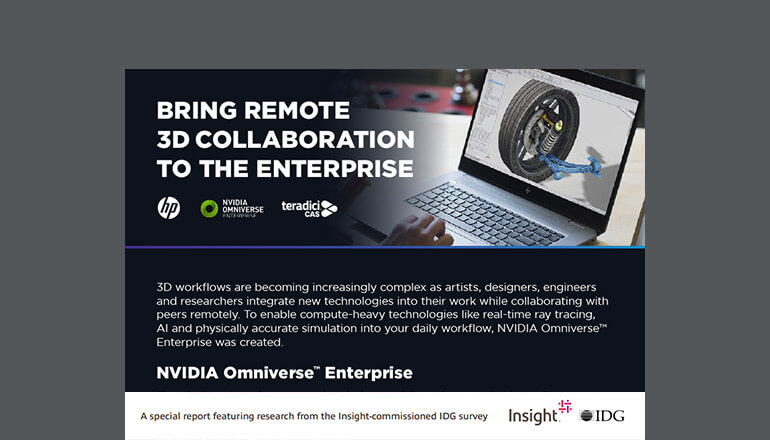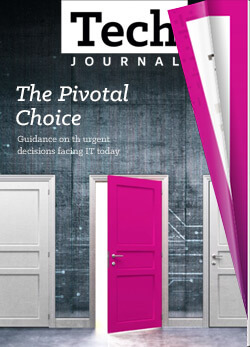Tech Journal Beyond the Enterprise: Building a Mobility Strategy for Small to Midmarket Businesses
By Aaryn Anderson / 19 Mar 2020 / Topics: Mobility

It’s no secret that the landscape for small to midmarket businesses is rapidly evolving. Between rising consumer expectations and changing dynamics in the workforce, organizations face increasing demands to modernize and deliver products and services in new ways.
Today’s customers have grown accustomed to levels of quality, responsiveness and personalization that were out of reach for most organizations just a decade ago. Now, the demand for a superior Customer Experience (CX) is almost universal. According to the third annual State of Connected Consumer report from Salesforce, 75% of customers now expect companies to leverage new technologies to improve their experiences and 73% say that one extraordinary experience raises the bar for all other companies.
And just as customer expectations continue to rise, so too do the expectations of employees. By 2020, MRI Network reports millennials will make up 50% of the U.S. workforce, soon to be followed by Gen Z. These digital natives have grown up using the latest and greatest devices — so it should come as no surprise that the expectation for seamless connectivity has extended to the professional world. Driven by their own experiences as consumers, the rise of remote work and this increasing proportion of younger generations in the workplace, today’s workforce demands to be empowered by the latest technologies.
But despite clear trends, many businesses are struggling to meet these demands.
The challenge of change
Salesforce recently reported more than 50% of customer experiences are still considered highly “impersonal” despite rising expectations for customization. 54% of customers say that businesses need to transform how they engage in order to meet their needs — and many are willing to stop buying from a company after just one sub-par experience.
Similarly, the 2019 Employee Engagement Report from TINYpulse reveals 43% of employees would be willing to leave their current positions for just a 10% pay raise elsewhere, up from 23% back in 2015. Among the top 10 pain points reported by workers, frustrations with technology ranked first on the list.
Outdated technology in particular has a tendency to alienate workers — especially as an increasingly distributed workforce begins to rely more heavily on technology for routine tasks. More than 93% of those surveyed by ZenBusiness said that problems with outdated technology have a severe impact on overall job satisfaction and performance. When employees are frustrated by company-issued devices or software they often resort to their own personal devices, exposing security vulnerabilities and creating compliance exploitations.
Viewed in this light, digital transformation can no longer be considered a luxury; it’s an absolute necessity for business survival.
But delivering a best-in-class experience for customers and employees alike comes with a unique set of challenges for small to midmarket organizations.
More than just mobile ― connected
So how can independent businesses begin to provide these types of enterprise-quality experiences for both customers and employees?
Most organizations are aware of the benefits of a mobile strategy. This is usually a short-term initiative focused on building an application or mobile responsive website.
A mobility strategy, by comparison, is about more than just building an app. It’s a comprehensive approach to the user journey as a whole, requiring a detailed understanding of different touchpoints to identify where mobile devices or applications can be used to optimize workflows, accelerate processes or deliver unique value.
An effective mobility strategy connects every employee and every customer across your business, providing a faster, easier path to access information, products or services. It allows you to personalize, build relationships and provide full 360-degree experiences that benefit not only end users, but your business as a whole.
Put into practice, workforce mobility has the potential to transform the way modern industries operate. In hospitals, nurses and care teams are using mobile devices to scan patient wristbands — streamlining paperwork and reducing errors. Mobile workstations and custom applications allow doctors to easily track progress during recovery, order prescription refills or host virtual check-ups with specialists. After discharge, patient-friendly apps answer follow-up questions and direct ongoing care.
Manufacturing and energy companies are using mobility strategies to streamline maintenance and inspection processes. With mobile devices and applications in-hand, field technicians can easily be alerted to equipment in need of repair, using step-by-step instructions to minimize errors and complete work reports on the go. Other solutions help retail workers locate products, receive inventory alerts and place orders on demand. This allows businesses to provide access to an “endless aisle” of products. Even when an item may not be in stock locally, it can be delivered straight to a customer’s door.
In each of these examples, we see a clear connection between the experiences delivered to employees and the experiences they, in turn, can deliver to customers. And as users on either side engage with devices and applications, they generate unique data which provides new opportunities to perfect future experiences and business outcomes.
Misconceptions about mobility
So, if overcoming the challenges of a changing workforce and rising customer expectations is as easy as building a mobility strategy, why have so many organizations failed to do so?
Many small to midmarket businesses still see these types of comprehensive technologies as “out of reach” for all but the largest enterprise organizations. But over the past decade, mobile devices have lowered in price, advancements in cloud and edge computing have made data more accessible, and managed services offer a path for even the smallest companies to get the support of a large IT team.
If your business is still on the fence about mobility, the following considerations may help tip the scale:
Simplicity — When it comes to deploying mobile devices or custom software, small to midmarket businesses have a significant edge on larger corporations. Developing and integrating solutions across a global enterprise is far more complex and time consuming than rolling out similar solutions across a handful of locations. The smaller and more central your business, the easier it is to implement device management or take advantage of zero-touch deployment options.
Affordability — Admittedly, bulk discounts may not play in your favor if you’re a small business, but the cost of mobile technologies and infrastructure has become more affordable in the last few years. More importantly, the cost of maintaining legacy apps and devices has continued to rise, especially when long-term issues with latency and security are taken into account. Modern solutions cost far less to operate and refresh, and higher trade-in values have made leasing programs an attractive option for many organizations.
Manageability — While managing devices and applications with an in-house IT team is always an option, it’s no longer a barrier to entry. Managed services provide the opportunity to outsource some or all aspects of your mobility strategy, reducing strain on internal resources while keeping costs under control. Additionally, Device as a Service (DaaS) offerings allow companies to take advantage of hardware leasing and end-to-end lifecycle services all in one, shifting from a CapEx to an OpEx model while ensuring your team always has access to the latest software and devices.
Steps to a successful strategy
Of course, just because a mobility strategy is accessible doesn’t mean it’s easy — like any strategic initiative, it has to be done right.
When mobility strategies fail, it’s typically due to a combination of poorly defined requirements or measurability, lack of support from leadership or lack of alignment to employee activities.
Ensuring success starts with a few key factors.
1. Talk to end users, early and often. Whether you’re designing a solution for employees or customers, it’s important not to make assumptions. Many projects start with IT teams or business leaders looking for a plug-and-play app to solve a poorly understood problem. Once the technology has been purchased and implemented, it becomes immediately clear that the solution doesn’t align to the real problem ― and can actually end up hindering engagement or productivity.
It’s critical to begin with careful observation, surveys or interviews of your end user. Take the time to understand the drivers and motivations of your employees or customers by following their journey from entry to exit, identifying frustrations, difficulties or gaps in communications along the way.
2. Clearly define your requirements. Once you understand the user journey, you can begin to develop an overall strategy for supporting both people and business processes. Identify employee touchpoints which need to be transformed and look for opportunities to streamline or automate tedious or manual activities. Then prioritize which indicators should be met in the near term vs. long term. What needs to be addressed immediately? Which requirements are less important or have a less immediate impact? Which have the highest potential return or long-term impact?
3. Create measurable indicators that can be championed. A successful mobility strategy is one that fulfills a need in a measurable way. Employees and leadership teams alike are far more likely to embrace new technologies and procedures when they see a clear benefit. Demonstrating value through time saved, processes optimized or dollars earned will help ensure buy-in at every level. This, in turn, will maximize the adoption and subsequent impact of your program.
4. Build it or buy it? Once you have properly defined requirements, with well-defined Key Performance Indicators (KPIs), you can begin to evaluate the effectiveness and ‘fit’ of ready-made solutions. There may be existing applications on the market which meet your needs, but it’s important to ensure you’re not trying to force a square peg into a round hole. Today, more flexible platforms make it possible to build custom solutions tailored to your specific requirements and, thanks to managed services, ongoing mobility management is no longer a barrier for smaller organizations.
Key takeaways
Mobility is creating new possibilities to improve customer experience, operational efficiency, workforce productivity and collaboration. Better experiences lead to more engaged customers, more productive and more satisfied employees, and lower attrition rates.
Application development is dynamic and agile development practices allow organizations to iteratively release features to provide immediate impact. With clearly identified goals that map back to business objectives, a mobility strategy is now more accessible than ever to companies of all sizes.
Go beyond mobile. See how our experts can help you build an effective mobility strategy that empowers end users and differentiates your business.















